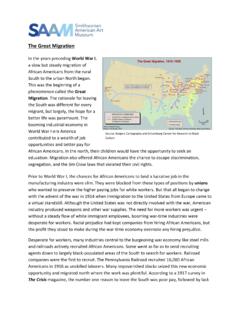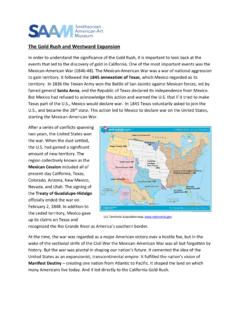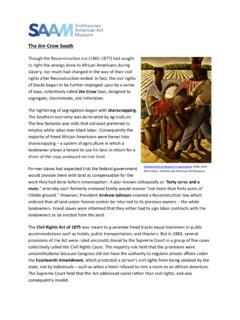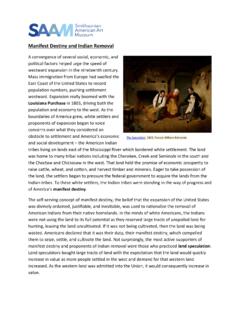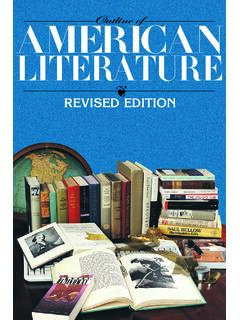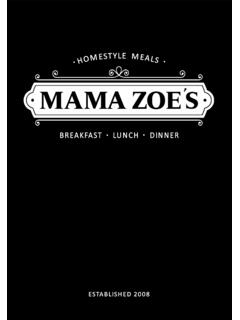Transcription of New York City: The Harlem Renaissance and Beyond
1 New york city : The Harlem Renaissance and Beyond When the Great Migration began, rural African Americans came to Northern cities to better their circumstances. The hardships and abuses they had endured in the South propelled them to seek a better future in the North, one of economic prosperity and freedom from persecution and Jim Crow laws. These Southern migrants joined established African american communities, strengthening church groups and fraternal societies. By 1920, the bulk of the African american population in northern states was concentrated in the cities of Cincinnati, Chicago, Columbus, Detroit, Pittsburgh, Philadelphia, and New york ; all industrial centers of production. In New york city , African Americans flocked to the city s Harlem neighborhood sowing the seeds for what would come to be known as the Harlem Renaissance , a cultural, social, and artistic revolution that flourished in the 1920s.
2 During the 1920s and 1930s, Harlem was a haven, a place of self-discovery, cultural awareness, and political activism for African Americans. It nourished an artistic flowering of unprecedented richness. It was literature, painting, and music; it was movies, poetry, and jazz. This concentration of talented and socially-conscious African Americans produced immense talent writers Langston Hughes and Zora Neale Hurston, artists Jacob Lawrence and Romare Bearden, musicians Bessie Smith and Duke Ellington, and activists like Marcus Garvey and A. Philip Randolph. The apartment blocks and brownstones of Harlem were opened to black residents in 1905. Between 1900 and 1940, the black population of the five boroughs of Manhattan rose from 60,000 to more than 400,000.
3 Black soldiers returning from World War I flocked to Harlem perhaps initially as a midway point on their way back home. In their travels abroad they had experienced the freedom offered in European cities and had seen the popularity of american jazz in Paris and London. The excitement of this new life was unimaginable in the small towns of the South, so many remained in New york . This largely transplanted community redefined the black experience in the United States. Empress of the Blues, 1974, Romare Bearden, Smithsonian american Art Museum By the 1920s Harlem had become the most famous African american community in the world. The concentration of black men and women in Harlem produced a lively scene. The accumulation of books, journals, and ideas sparked interest in African music, images, and history.
4 The 135th Street Library, depicted in Lawrence s The Library, became the cultural linchpin of Harlem . It was a resource for artists and thinkers, a meeting place, the site of fierce intellectual debates, and a venue for plays and musical performances. In a cosmopolitan community people expressed their enthusiasm for this new life through jazz, dance, theater, art, and writing. The Harlem Renaissance coincided with the Roaring Twenties and the Jazz Age. The impact of these movements had a drastic impact on an individual and collective level in both the African american community, as well as America s cultural industries. The contributions of African Americans greatly benefited the film, music, and theater industries. Some, like the poet Countee Cullen, were Harlem -born; others like Langston Hughes migrated.
5 A nineteen year old Langston Hughes, born in Joplin, Missouri, arrived in Harlem in 1921 and vividly recalled his excitement of seeing Harlem for the first time: I can never put on paper the thrill of that underground ride to Harlem . I had never been in a subway before and it fascinated me the noise, the speed, the green lights ahead. At every station I kept watching for the sign: 135TH STREET. When I saw it, I held my breath. I came out onto the platform with two heavy bags and looked around. It was still early morning and people were going to work. Hundreds of colored people! I wanted to shake hands with them, speak to them. Hughes would become one of Harlem s most famous residents, a literary giant whose poems chronicled the struggles and joys of early twentieth century African Americans.
6 He and other young writers and artists would take ownership of the Harlem Renaissance movement, giving a voice to the African american experience. The Library, 1960, Jacob Lawrence, Smithsonian american Art Museum When Alain Locke published The New Negro in 1925, Harlem s political and cultural facets gained a sharper focus. Literary contributions by Countee Cullen and Zora Neale Hurston spoke of the black experience, but Locke s book offered far more than a record of daily life with its joys and sorrows. Locke sought to reestablish art as the core of black life. He argued that African Americans should express an African art uncontaminated by the industrial age, rooted in pure ethnic craft and tradition. Through The New Negro, he called on African Americans to accomplish this task.
7 Photographer James VanDerZee was the semiofficial photographer of Harlem s life and people. His images traveled throughout the country in magazines and book illustrations. VanDerZee had a portrait studio, but he also worked on the street, recording the details of everyday life, both political and personal. His images helped disseminate sociological concepts on race articulated by African american leaders Du Bois, Alain Locke, and Marcus Garvey. Sculptor Augusta Savage produced images that ranged from street urchins to idealizations of the African muse, and ran a series of schools for budding artists. The artists of the Harlem Renaissance sought to explore and represent the African american experience in their work. They fostered a new sense of pride in the black community and provided a voice to the desire of African Americans to at long last achieve a measure of equality in american society.
8 The influence of these artists resonates far Beyond the place and time in which they worked; it has been felt throughout the century and the whole of american culture. A Changing city In the nineteenth century, the city of New york had been characterized by a variety of land uses which separated people of different ethnic groups and economic classes. But as more and more people poured into urban centers in the early twentieth century, the spatial arrangement of people and economic activities became altered by innovations in mass transit and building construction. In New york city , the first subway opened in 1904, its tunnels excavated out of clay and rock by the vast numbers of largely Irish, italian , and German immigrants. Between 1900 and 1920, New york built 100 miles of subway tunnels.
9 Thanks to the subway, people Evening Attire, 1922, James VanDerZee, Smithsonian american Art Museum were no longer segregated to one part of the city . Those who had migrated to this evolving urban environment from the South experienced a vastly different world than the one to which they had been accustomed. Hungarian- american artist Lily Furedi s painting Subway typifies this lack of segregation on the New york subway. Passengers of different races, classes, genders, and national backgrounds ride together with no sign of friction a marked contrast to the institutionalized racial segregation which was the case at this time in the southern United States. Furedi s clean, pleasant depiction of the interior of a subway car is a particularly optimistic view of a new train car running on the new Eighth Avenue Line, built in 1932.
10 She painted Subway in 1934 for the Public Works of Art Project (PWAP), the first of the New Deal national art programs of the Great Depression. The PWAP suggested that artists depict aspects of "the american scene." Furedi, like many New york city artists, chose to show a familiar aspect of urban daily life that would have been familiar to millions of New Yorkers. People from all economic backgrounds could afford to ride the subway because of the traditional 5 cent fare. Newspaper articles from the 1920s note that people of all different national backgrounds rode together on the New york subway, often reading newspapers in wide range of languages, and casually reading over one another s shoulders as we see happening at the left in Furedi s painting. Though the New york city subway system was not segregated, there had been some discussion of setting aside special cars for women mostly to avoid issues of harassment.
